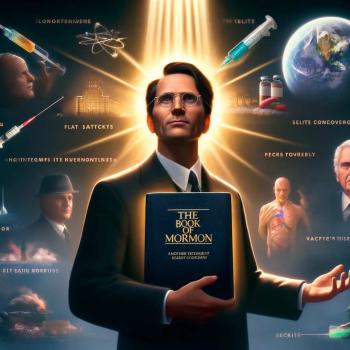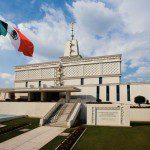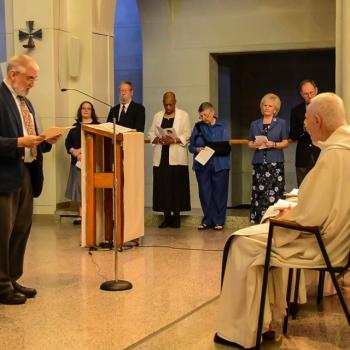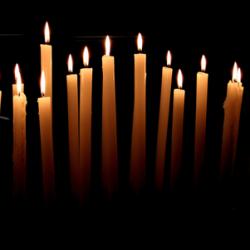The best way to understand Christian mysticism (if “understanding” is even a possibility, given the mysterious nature of mysticism) is to approach it as a process: a developmental journey of how one relates to God.
Process, Development, Journey, Relationship. Mysticism is dynamic, not static. More verb than noun. It’s something we do — in response to the love of God.
Christian Mysticism begins with God. In this dance, God is Fred Astaire and the human being(s) — whether a single, individual, or the collective “Body of Christ” — is Ginger Rogers. God leads, we follow. God asks, we answer. God initiates, we respond.
And what is at stake is more than just a dance. We are offered a relationship — there’s a reason why marriage is a metaphor that shows up again and again in the writings of the mystics. Mysticism is a process of entering into an ever-deepening relationship with God: from an initial experience of longing or desire, to a gradual growth of friendship, intimacy, and love, to the consummating bliss of nondual union.
In her masterpiece The Interior Castle, the Spanish mystic Teresa of Ávila suggests that there are seven “mansions” or stages in the mystical life. A few centuries before her, the Flemish mystic Beatrice of Nazareth wrote a short treatise called “The Seven Manners of Divine Love” (now published with her biography). Like Teresa, she offers a model of seven phases or dimensions to the journey into the love of God. While I cannot dare to compare myself to either of these contemplative masters, I’m borrowing their model of a seven-step journey for the mystical life, to chart my own understanding of how the process of an ever-deepening relationship with God might play out in many people’s lives.
Try not to see this as a strictly linear model of mysticism. Relationships are holistic, embodied and complex. I’ve been married to my wife for over a quarter century now, and I am still learning new things about her — that’s step one in my relationship model! I don’t think this means I’ve been a sub-par husband (although I suppose that’s possible), but rather it shows how relationships are always imbued with mystery, and as two human beings grow and develop, a relationship will always yield new insights and now ways of understanding one another. What is true between two human beings is even more the case with God. In God’s infinite splendor and ever-blossoming perfection, we mere mortals can expect the journey to union to be ever-in-process, so all the stages of this journey can, may, will happen simultaneously. This is not a ladder to climb, it is a country to dwell in, and in this country we can and will have access to all the ways of relating to God, at all times (which means, even a beginner might suddenly plumb the depths of nondual union — maybe only in a fleeting moment of ecstatic wonder, and always entirely in God’s control — but it remains an ever-present possibility).
So, here then, for your consideration: seven dimensions of the process of relating to God.
- Discovering God
- Pondering God
- Seeking God
- Encountering God
- Loving God
- Imitating God
- Union with God
Let’s look at each of these in turn.

Discovering God
Every journey begins somewhere. I still remember my mother telling me about God when I was a small boy. “God made you,” she said, as she put socks and shoes on my feet. “God made my feet?” I asked, wanting to make sure I understood this new concept fully. “Yes, even your feet. God made all of you.” Looking back now, I can smile at this early catechesis — and the gentle irony of my mother, who created me physically, teaching me about God as my spiritual creator. But the point is, we all discover God at some point, in some fashion. Maybe it’s at church, or from friends, or family members. Maybe we are exposed to Bible stories, or lives of the saints, or works of art. But somehow, in some form or fashion, God is presented to us.
How that presentation is made can be crucial: if we learn at the beginning that God is just a myth, we may never open our hearts to consider that this “myth” might bring us life and joy. Perhaps even worse, if we are taught that God is angry and judgmental, we may resolve to do all we can to keep God as far away from our hearts as possible!
But if all goes well, learning about God is like someone saying, “I have this friend who I think you’ll hit it off with, I want you to meet them.” It’s not the same thing as meeting the friend for yourself, but it is a stage on the journey. And as I have already pointed out, even in human relationships we continue to discover new things about the people in our lives, year after year. So we never stop “discovering” God — which is why it makes sense to read the Bible daily, pray daily, attend Mass regularly, and so forth. Yes, the stories are the same: but the lessons we learn can vary deeply over our life-span. When the object of our discovery is infinite, naturally there is no end to the possibilities we can encounter.
Pondering God
It’s one thing to hear, or read, what others have to say about God — and another to begin to cultivate a sense of who God is, in our own hearts and minds. I started this process right away: when my mom said God created me, I had to find out if that meant God was in the foot-making business as well. It’s natural to have questions about God, to experience a sense of wonder, or mystery, or awe when we reflect on the God that others have introduced us to. What does it mean to be created? To be loved infinitely and unconditionally? To be asked to make changes in our lives to bring them more in alignment with love, compassion, and mercy?
What is the personality of this God? Can this God be known? Does this God really care about me? How does God relate to philosophy or science or psychology? Is God just a myth? A crutch for people who do not know how to manage the complexities of life? Or perhaps could God be inviting us to enter into those complexities more fully, only by bringing a sense of God’s grace into the challenges we face?
Like discovering God, pondering God — thinking about God, reflecting on God, learning more about God, even meditating on God — is with us throughout our lives. We never graduate beyond this foundational dimension of relating to God. We learn that, since God is not physically embodied, that we “meet” God in our own bodies, our hearts and minds. We discover, sooner or later, the value of silence as the “habitat” for pondering God. And sooner or later we also discover that God can sometimes seem very close to us, intimately present in our hearts, but also at times may seem far away. This leads to the next dimension of relating to God: seeking.
Seeking God
Meditating on, or pondering, God may lead us to the first crisis of the spiritual life: a sense of God’s absence. We pray, and our prayers seem to bounce off the ceiling. We ask God for a sense of God’s presence or a feeling of being loved and forgiven, but no such conscious grace seems forthcoming. We are told that God is everywhere, and logically that includes “within” us — but God seems to be adept at playing hide and seek. “Truly, you are a God who hides himself,” wryly notes the prophet Isaiah (45:15). We have to make peace with this apparent hiddenness or absence of the Divine: what puts the mystery into mysticism.
“Blessed are the pure of heart, for they shall see God” promises Jesus (Matthew 5:8). So we look for ways to purify our hearts, or minds, or vision. But then Exodus 33:20 quotes God as saying “you cannot see my face; for no one shall see me and live.” So perhaps this is beyond our control: the sense that relating to God will always entail a dimension of unknowing, darkness, hiddenness, and elusiveness may just be part of the territory. If we persevere in seeking God, we may discover that the rhythm of relationship with God is a rhythm of seeking — and finding. Sometimes, God does seem present: in our feelings and intuition, at least. Which leads us to the next dimension of the mystical life.

Encountering God
The wonderful English mystic Julian of Norwich sees prayer as involving two dimensions: seeking, and beholding. “Ask, and it will be given you; search, and you will find; knock, and the door will be opened for you,” promises Jesus in the Sermon on the Mount (Matthew 7:7). If God were only experienced as hidden or absent, sooner or later people would abandon the search. But many people do report having a sense of God’s presence. It may be strictly intuitive, an undefinable feeling or sensation, but it’s real enough that it motivates many people in every generation to dedicate their lives to God, to the wisdom and challenge of a spiritual life.
“God is not elsewhere,” as a friend of mine puts it. Julian’s lovely word “beholding” invites us to consider that we may encounter God, at any time and in any location, often when we least expect it. “We believe the divine presence is everywhere,” proclaims St. Benedict. St. Ignatius of Loyola wrote in one of his letters, challenging his correspondent to “find God in all things.” Learning to trust this intuitive capacity to sense or feel God’s presence becomes a defining feature of a spiritual life — and the foundation of the ever-deepening depths of intimacy with God that are to come.
Loving God
Remember that I said God is the active agent in the mystical life? So perhaps this dimension of the relationship should be called “Responding to God’s Love.” As the New Testament puts it, “We love because God first loved us” (I John 4:19). But unfortunately, many of us do not always have a loving relationship with God — we have been taught that God is angry with us, that God’s judgment overshadows God’s mercy, that God is stern and distant, that God mainly wants our obedience and compliance. Not only do these images of God fail to express the fullness of the beauty of Divine Love, but they can often function as spiritual obstacles, disincentives that keep us motivated to stay away from God, rather than to draw closer.
Don’t get me wrong: I believe God wants what’s best for us, which includes wanting us to turn away from anything that limits our freedom, undermines our life, and causes harm to us or to our relationships. Love does not settle for the corrosion of sin. But love is infinitely patient, kind, merciful and caring — God wants to heal us, not condemn us; so God is looking for every opportunity to transform our fear into love, our despair into hope, our sadness into joy, and our dread into peace. So this stage of the mystical journey is a stage of learning to accept the infinitely good news of God’s love — and learning to respond to that love, by loving in return — not only loving God, but loving others as we love ourselves — even loving God’s creation, and even loving those who experience as “enemies.” Jesus is clear in his teaching: we are called to love them all! But we can do this — we can love — because God’s love is poured into our hearts (Romans 5:5); our task here is to discover that infinite well of Divine love within us, and access it both to return love to God and to freely share it with others.
Where does loving God (beginning with being loved by God) ultimately take us? “For it is written, ‘You shall be holy because I am holy'” (I Peter 1:17) — in other words, when we calibrate our relationship with God to love, rather than fear or mere duty/obedience, then we have opened our hearts to the next dimension of this relationship: to become more and more like that source of Love.
Imitating God
When I first sketched out this model of the mystical life, I called this stage “Yielding to God.” I still think that works particularly well as a description of this deep level of intimacy. But when I think about how, after many years of marriage, my wife and I have picked up many elements of each other’s personalities: from the stories we tell, to ways we approach the world, to even mannerisms and favorite words — I began to see that imitation really is a dimension of intimacy. I once heard a monk criticize the classic book Imitation of Christ, saying that contemplative spirituality is not about imitating Christ (or God) so much as it is about intimacy with the Divine. The monk had a point — up to a point. I think we can use imitation as a shield to prevent us from seeking intimacy: “My job is to conform myself to God’s will, which I can do safely from a distance.”
So in that sense, I agree with the monk, that intimacy matters more than imitation, which is why I think this needs to come after the experience of receiving and responding to Divine Love.
But I think if one is truly dedicated to intimacy with God/Christ, then the experience of imitation will naturally follow. This is not about self-abnegation, even though traditionally there is a lot of language about “dying to the self.” Think of it as “dying to anything inauthentic or broken/wounded/sinful” in the self. Such a death may feel all-encompassing, since most of us have been wounded by sin and human brokenness in fairly deep ways. But God’s desire is not to destroy us, but to heal us, to make us whole. So the imitation of God is the imitation of Love — of Joy, of Peace, of all the fruits of the Spirit (with capital letters). In imitating God’s goodness and truth and beauty, we become more truly our most real and authentic selves. We truly become all that we were created to be. And this both builds on all the dimensions of Divine Intimacy that we have already embodied, even as it sets the stage for the ultimate end of the mystical life: nondual union/communion with God.

Union with God
I certainly do not feel qualified to write about this, the heart of the mystical life and the ultimate goal of every contemplative seeker. As a matter of faith, I believe that union with God is already always present in every human heart: “In God we live and move and have our being,” as Saint Paul puts it in Acts 17:28. Or in the words of Saint Peter, we are “partakers of the Divine Nature” (II Peter 1:4). There have been just a handful of graced moments in my life when I believe I have been given a glimpse of just how profoundly beautiful and joyful this reality is. I imagine that our conscious awareness is shielded from the full extent of this reality because for most of us, truly knowingand experiencing such Diving union would probably be, metaphorically speaking, the spiritual equivalent of blowing our fuses. “There is no way of telling people that they are all walking around shining like the sun,” as Thomas Merton once drily put it.
We may be shielded from it, but I do believe most of us are given glimpses of it, probably in proportion to how willing we are to notice it when the glimpse is given. It may well be that we all are given glimpses of the splendor of Divine Communion multiple times each day, but our conscious minds (“the ego”), busy with the tasks and responsibilities of surviving in the physical universe, simply filters such moments of mystical joy out of our awareness — so they remain unacknowledged in the shadow of our unconscious, where they emerge as the experience of restlessness, yearning, longing, sehnsucht. So we cycle back to the earlier stages of this relationship journey: discovering what we can about God, pondering what we have learned or experienced, noticing the restlessness in our hearts, and then seeking to find traces of God in our hearts, our minds, our environment, our relationships. And the cycle continues.
Does this mean we will never experience the fullness of Divine Union? I wouldn’t be so pessimistic. The lives and writings of the mystics are filled with surprising stories of sudden recognition of Divine Union. It happened to Thomas Aquinas, a Dominican priest, while presiding at the Mass; it happened to Julian of Norwich while sick in bed; it happened multiple times to Thomas Merton: in church, on a busy street corner, and in an ancient Buddhist temple. Again, the words of Merton: there is “no program for this seeing. It is only given. But the gate of heaven is everywhere.” Perhaps what makes the great mystics “great” is their ability to embody this depth of union/communion in a more full and lasting way, and/or to write about it or speak about it in such a way that the rest of us find that our hearts leap in intuitive recognition. But I believe the gift is available to everyone. Like Merton, I am convinced there is “no program” by which we can engineer the experience of Union. Our job is to make sure our hearts are open so that when the gift is given, we are awake and aware to receive it, cherish it, and allow it to transform our lives so that we may more fully embody love.
Okay, my friends: this is my understanding of the process of Christian mystical spirituality. Once again, it’s not linear. You can hop on the train at any station, and the itinerary may change from day to day or moment to moment. What’s important is that we embrace the journey and begin the pilgrimage. So let’s go!
Enjoy reading this blog?
Click here to become a patron.


















